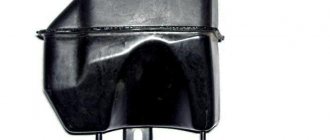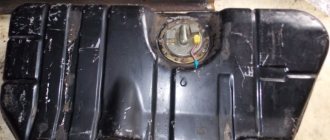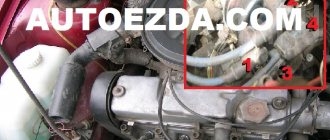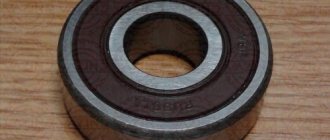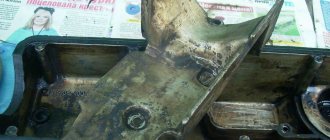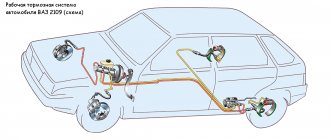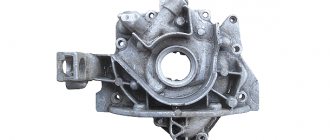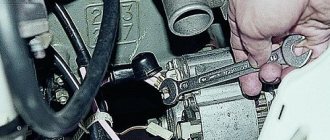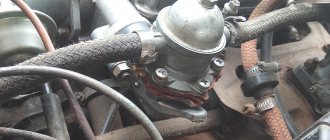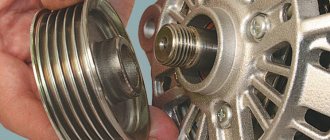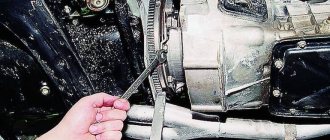A modern muffler in a car, despite the apparent simplicity of its design, is a high-tech device whose task is not only to remove exhaust gases from the exhaust system, but also to reduce the noise level, which is carried out by cutting off alternating pulses of high and low pressure exhaust gases formed in result of engine operation.
From the article you will learn what types of car mufflers there are, their structure and design features. Let's talk about the design of mufflers for VAZ 2101/2107/2109/2110, Oka, UAZ, and also consider how to make the device yourself.
Muffler device for VAZ 2108 and 2109
It should be noted right away that the mufflers of the VAZ 2108 and VAZ 2109 cars are practically no different from each other in design. The only difference is the dimensions: the exhaust pipe on the “nine” is 8 cm longer.
The muffler on VAZ 2109 and 2109 cars consists of two parts:
- main muffler;
- additional muffler (aka resonator).
The main muffler body has the shape of an oval pipe and is made of alloy steel. The housing has a number of partitions that form resonator compartments. There are also two exhaust pipes (exhaust and inlet) and the main exhaust pipe. All these elements are connected using rolling. Spot welding is practically not used in such devices, so as not to reduce their corrosion resistance.
The resonator body is a round tube with an aluminum coating. Inside there is another pipe with holes, at the ends of which there are mounting flanges. With their help, the resonator is connected to the gas receiver of the car.
Muffler device (diagram)
The design of the muffler has already been partially discussed, now let’s delve deeper into the topic.
You probably already realized that mufflers have many distinctive features; no devices have the same design; each manufacturer introduces its own innovations to improve the design of its brainchild.
The main goal is to reduce the sound as much as possible without losing engine power.
In a typical production car, the muffler takes from 5 to 7% of the power. To achieve absolute silence, you need to either increase or install an additional device with a resonator, and this will take another 5 to 7% of the power. The total is 10–15%, which no one wants to lose.
Those. It turns out that it is not so easy to make an ideal muffler so that there is little noise and no loss of power.
The design of the product is largely influenced by:
- Engine capacity;
- Tuning or regular engine installed;
- Make of the car and its purpose (sports or regular);
- Who is the manufacturer.
The classic muffler for most cars consists of:
- Inlet and outlet pipes;
- Internal pipes;
- From two or more expansion chambers;
- Internal partitions;
- Helmholtz resonator.
The sound entering the device through the inlet pipe is reflected from the walls and travels a distance of more than 1 km, constantly weakening.
The resonator serves to weaken the most powerful component of the sound wave, which a conventional labyrinth cannot cope with.
The chambers in the muffler are of different sizes because the length of the sound waves is also different.
The inlet pipe, as a rule, has holes and is considered dissipative, since sound entering it is partially dissipated in the first chamber.
The waves move chaotically in space, reflecting from the walls and constantly losing energy. This occurs due to the force of friction against air molecules.
The more of the wave remains in the first chamber, the more the wave attenuates.
The remaining waves pass into the second scattering chamber; however, it is not easy for them to pass from a narrow pipe into open space since, according to the law of acoustics, a sound wave seems to collide with a wall of air.
Part of the wave is not able to enter the second chamber and is reflected back from the interface and partially absorbs the oncoming flow.
The same waves that were able to get into the second chamber are randomly reflected from the walls, absorbing each other and losing energy during friction with the air.
But the main component of the sound wave passes further and enters the Helmholtz resonator.
The sound wave again has to leave the narrow space into the free chamber, and it seems to press on the air in the resonator, creating air vibrations.
This creates a reverse sound wave that has the same frequency as the original one. They collide and destroy each other.
Some of the waves remaining in the second chamber enter another pipe and are transported to the third chamber.
There again, sound loss occurs due to friction with the air, and only after this the weakened wave enters the output pipe, and from there out.
How to determine whether a muffler is faulty
It is not difficult to understand that the muffler of a VAZ 2109 car is faulty:
- the volume of the engine increases sharply, the engine begins to growl;
- In this case, the engine power is reduced by two or even three times;
- the cabin smells of exhaust fumes;
- if the driver does nothing, the growl of the engine is replaced by a deafening roar, which can sometimes be accompanied by pops similar to pistol shots.
All this suggests that a hole has formed in the muffler housing. If you don't do anything about it, then problems are inevitable:
- If the muffler is faulty, carbon dioxide contained in the exhaust gases may end up in the vehicle interior. This gas is colorless and odorless, but causes severe headaches and dizziness. And if exposure to dioxide lasts for a long time, it can lead to the death of the driver;
- Driving with a faulty muffler cannot be called comfortable;
- Driving with a faulty muffler is expensive: there are rules to limit noisy driving. Violation of these rules may result in fines.
Types of car mufflers
Modern mufflers are divided into three types: dissipative, reactive and combined.
In turn, the above types are divided into two types: direct-flow and labyrinth.
Dissipative (absorbing).
They belong to the type of direct-flow mufflers and have a simple design.
Consist of:
- Housings;
- Perforated pipe;
- Inlet and outlet pipes;
- Special heat-resistant sound-absorbing filler;
- Steel mesh;
- All this is connected by all-welded joints.
The principle of operation is simple - sound-producing exhaust gases enter a chamber from a perforated pipe where they are absorbed by heat-resistant sound-absorbing material, resulting in the energy of sound vibrations being converted into thermal energy. Mineral wool, metal shavings, and glass wool are often used as such materials.
The advantage of such a muffler is that, depending on the design, it allows you to increase engine power by 5 - 7%, because there is practically no resistance to the exhaust gases escaping.
The disadvantage is increased noise, so such products are primarily tuning and are rarely used on ordinary cars, as a rule, only on sports cars.
Structurally, absorbing silencers can be:
- Strongers or “louvered core glasspack”. They are a pipe with metal petals pressed inside. They are considered ineffective in terms of purging and are rarely used. Mistakenly installed instead of a catalyst.
- With internal diffuser. Not expensive products that have their pros and cons. In terms of noise reduction, they are more effective than other analogues, but in terms of purging, it’s the opposite. The only tangible plus here is the low price.
- With perforated cones of different lengths, treat them as a combined solution. The cones are welded into the main perforated pipe, which significantly reduces noise and at the same time the flow of gases is quite satisfactory for many.
Reactive.
The operating principle of such mufflers is based on the effect of damping reflected waves from each other, which leads to a reduction in noise.
In this design, filling material is not provided; instead, additional pipes, chambers and partitions are welded into the body, chaotically reflecting from which sound waves are damped.
But such mufflers can rarely be found on tuning and sports cars, since their design does not allow achieving good results in terms of aerodynamics, the reason being the high turbulence of the exhaust gases.
Also, in terms of design, reactive analogues are complex and therefore are mainly manufactured in factories.
Diagrams and brief characteristics of reactive mufflers are presented below.
Combined.
This form embodies design solutions from reactive and dissipative mufflers. For example, you can take devices with perforated cones (see above).
They have good efficiency in terms of noise reduction, but in terms of gas flow, the performance is low.
Main malfunctions of VAZ 2109 and 2108 mufflers
There are several typical muffler breakdowns that owners of VAZ 2109 and VAZ 2108 cars encounter:
- Holes appear in the main muffler housing. Due to high temperatures accompanied by strong vibration, the case simply burns out. The cause can be either thermal or chemical corrosion. The problem is solved by applying a patch and subsequent welding of the damaged body;
- The muffler constantly overheats. As a rule, this occurs due to coking of the holes in the resonator partitions. In this case, hot exhaust gases accumulate in the silencer, and engine power rapidly decreases. To eliminate the problem, the muffler body is opened, damaged resonator partitions are replaced with new ones;
- The muffler is ringing. Ringing in a muffler occurs when the resonator partition in its body is completely or partially torn off. The problem is eliminated in the service using spot welding;
- The muffler is knocking. This is observed when one or more mounting hangers are broken. After this, the muffler body begins to dangle under the bottom of the car, periodically hitting it. It is not possible to fix such a breakdown on the road. The only way out is to slow down to a minimum and drive to a car service center with an inspection pit, where mechanics can replace the broken fasteners.
Intake pipe diameter 2109
- To the beginning of the forum
- Forum Rules
- Old design
- FAQ
- Search
- Users
Literally after purchasing the car, a rattling sound appeared in the bottom area. The reason is the metalgraphite ring after cat. collector
A groove appears on the surface of the ring. Apparently it siphons through it. At least that's how it was with the first one.
Vladrive
Development in the form of broken edges, chips. Stretching what? There's nowhere to go any further.
Vlad B
I tried it. Graphite lubricant flows out very quickly, and the graphite then blows out. The springs are in place.
I wonder if red ABRO sealant will help?
On the box it was written VAZ 2112 catalyst repair kit. Manufacturer: AvtoVAZTekhKomplekt, if I'm not mistaken.
Guys, my exhaust sound seems to have become louder, like a sraker, almost the car is only 3 months old. maybe because of this ring. how to treat?
On the box it was written VAZ 2112 catalyst repair kit. Manufacturer: AvtoVAZTekhKomplekt, if I'm not mistaken.
Place the rings on graphite lubricant and do not throw away the springs.
in vain.. the ring must be soft, then all cooperative collective farm delights. Then it fits clearly into place and does not siphon
Vladrive Destruction in the form of broken edges, chips. Stretching what? There's nowhere to go any further.
Vlad B Tried it. Graphite lubricant flows out very quickly, and the graphite then blows out. The springs are in place.
Source
Replacing the muffler on VAZ 2109 and 2108
Replacing a muffler on VAZ 2109 and VAZ 2108 cars always begins with the selection of the necessary tools and materials. Here's what we need to get started:
- new muffler;
- set of open-end wrenches;
- set of socket heads with ratchet;
- pliers;
- flashlight.
Sequencing
In order for the result of the work to please the car owner, it is advisable to act according to the following algorithm:
- The car is installed on the inspection hole. The engine is turned off and wheel chocks are placed under the wheels.
- The muffler pipe is disconnected from the resonator pipe. To do this, the nut on the clamp is held with a 13-mm open-end wrench, and the bolt from below is unscrewed using a socket head with a ratchet.
- The clamp, freed from the bolt, is slightly bent with pliers and removed.
- The muffler is held under the bottom by a system of rubberized suspensions. There are three hanging hooks on the muffler body. To remove the muffler, you need to lift it slightly so that all the hooks are disengaged (usually at this moment a characteristic click is heard).
- The muffler removed from the hangers is removed from under the car.
- A new muffler is installed in place of the old muffler. All installation operations are carried out in reverse order.
When installing the silencer, you should pay attention to the reliability of the connections and make sure that it is correctly secured under the bottom of the car.
Video: removing the muffler on a VAZ 2109
Muffler VAZ 2108 dimensions
The exhaust system of carburetor engines of VAZ 2108, 2109, 21099 cars consists of three parts: a receiving pipe, an additional muffler and a main muffler.
The parts of the system are connected to each other by means of flared pipe ends and metal conical sealing rings located between them, clamped with clamps. The system elements are attached to the engine exhaust manifold with a flat flange on the exhaust pipe, through a gasket and four studs with nuts. Elements of the exhaust system of VAZ 2108, 2109, 21099 cars
The exhaust system is suspended from the body by brackets on rubber cushion rings (5 pieces). In the front part, the exhaust pipe is additionally secured with a bracket from the engine.
The exhaust pipe of the exhaust gas exhaust system consists of two pipes attached on one side to a flange, on the other to a gas receiver consisting of two stamped metal halves. The gas receiver, on the side of the additional muffler, ends with a metal intake pipe flared at one end. The gasket between the exhaust pipe flange and the engine exhaust manifold flange is made of asbestos reinforced with perforated steel tape.
An additional muffler (resonator) consists of a housing with a perforated pipe and partitions inside. The additional muffler pipes also have flared edges for connection to the exhaust pipe and the main muffler. The outside of the optional muffler can be treated with aluminum to improve corrosion resistance.
The main muffler also consists of a housing with perforated pipes and partitions inside. The housing can be made of stainless steel to prevent corrosion. Two pipes are attached to the muffler body: on one side, flared, for connection with an additional muffler, on the other side, straight, for exhaust gases.
Both mufflers do not have welding points and are assembled by rolling parts to prevent corrosion.
Diagram of the exhaust system of a carburetor engine of VAZ 2108, 2109, 21099 cars
Notes and additions
— On VAZ 21081 cars, the muffler exhaust pipe is single, not double, since the exhaust manifold of the 21081 engine has one hole.
— The exhaust system of the injection engine of VAZ 2108, 2109, 21099 cars is discussed on our website in the article: “Exhaust system of the injection engine of VAZ 2108, 2109, 21099 cars.”
1. Resonator Nissan Tiida 20300-EM12C, article number CBD120.005 2. Resonator Renault Symbol, article number CBD126.002 3. Resonator Renault Sandero/Stepway I, article number CBD126.001 4. Intake pipe with corrugation Kia Cee'd II, KIA Rio , article number TAL003 5. Muffler pipe bend (pipe Ø63.5 mm, angle 45°), article number d6345 6. Muffler pipe bend (pipe Ø63.5 mm, angle 60°), article number d6360 7. Muffler pipe bend (pipe Ø63. 5 mm, angle 90°), article number d6390 8. Mini-catalyst angular, article number MC104
Assembly of a double muffler for a VAZ 2109
Before describing the process of assembling a double muffler, I would like to note that in order to successfully carry out such an assembly, the driver must be able to work with a welding machine. If you don’t have such skills, it will be much easier to buy a ready-made double muffler for the VAZ 2109 in a specialized store.
Double muffler assembly sequence
To install the muffler, follow the sequence of operations:
- The muffler is removed from the car in accordance with the instructions presented above.
- A hole for a pipe with a diameter of 5 cm is carefully cut out on the side of the muffler body. Then the upper part of the muffler body is carefully cut off, and all resonator partitions are removed. In their place is installed a perforated metal mesh, twisted into a tube.
- The pipe is inserted into the body and welded to it. Its end is inserted into a twisted perforated mesh, in which a hole is previously cut. This end is welded to the mesh.
- A pair of L-shaped pipes are welded to the standard muffler pipes.
- For heat and sound insulation, the entire structure is filled with glass wool.
- The previously cut off upper part of the muffler housing is put in place and welded. The resulting design is shown in the photo below.
- Now the double muffler is installed on the car.
Replacing a muffler is not a particular problem even for a novice driver. All you need is a viewing hole, a couple of keys and a little patience. But the repair of this device almost always involves welding work. And if the car owner does not have such a skill, then it will not be possible to do without the help of qualified auto mechanics.
The most common problem with the VAZ 2109-2108 exhaust system is muffler burnout, and this often happens even after 50,000 km. Here, first of all, everything depends on the quality of the steel from which it is made. The factory one, as a rule, lasts much longer than the ones installed afterward, since the quality of the original parts is somewhat higher. If your car's muffler is burnt out, it needs to be replaced.
Of course, there are some owners who try to repair the burnt areas, but such “patches” obviously won’t last long, and sooner or later you will still have to replace the part with a new one. For this job you will need the following tool:
- head deep 13
- ratchet handle
- open-end or socket wrench 12 or 13 (depending on the installed mounting bolt)
So, the first step is to disconnect the muffler from the resonator, for which you need to unscrew the clamp. Use one key to hold the bolt from turning, and use the second to unscrew the nut:
Intake pipe diameter 2109
- To the beginning of the forum
- Forum Rules
- Old design
- FAQ
- Search
- Users
Hello comrades. please tell me the diameter of the pipe in this place (marked in red). I decided to weld the corrugation, I read that the vibration would decrease. How many times has the car been in the pit, but I don’t remember what the diameter is))), so as not to be fooled by the corrugation. Maybe someone has already done this, please share your impressions, otherwise maybe you won’t have to do it.
| Sistema_vipuska_dlya_VAZ_2108_09-099-10-13-15_b8.jpg | |
| Description: | |
| File size: | 20.46 KB |
| Viewed: | 263 times |
51 mm there. I can say for myself that no corrugation is needed there. The original ring can be replaced in 10 minutes and costs 200 rubles, but the corrugation will have to be welded, and it will last 3-5 years
How long does the original ring last?
Serg_x
that is, you want to say that all this is bullshit mixed with corrugation. and this ring copes well with vibration?) Then why does the silencer continue to vibrate during operation. at least you can see how its end is shaking.
Well, basically, if the end shakes, it’s bad
assumed vulgarity
well, that's just to relieve the situation))
How long does the original ring last?
that is, you want to say that all this is bullshit mixed with corrugation. and this ring copes well with vibration?) Then why does the silencer continue to vibrate during operation. at least you can see how its end is shaking. 3-5 years is a breeze.
Why put it there, explain?
sanyamen68
The corrugation does not reduce vibration, it is only needed for a sealed flexible connection and perfectly transfers vibrations (if any) to the silencer.
At one time I hesitated to change the graphite rings, so I installed metal ones.
It fit perfectly with the original resonator - hermetically sealed (until it burned out), but with the new resonator (not factory) it does not fit in any way. I sharpened the ring, ground it to the flange cup with lapping paste, it still fits poorly.
Source
Features of the system design
The structure of the exhaust gas removal system has a similar structure on all domestically produced cars. One such example is the VAZ 2109.
The exhaust system of the car in question has the following structure:
- Receiving type pipe. A special-purpose probe is mounted in the pipe cavity. The capabilities of the device include processing the composition of emitted gases, which makes it possible to analyze the mixture used as a flammable liquid and, according to incoming data, make the necessary changes, which implies monitoring the quality of the liquid;
- A catalytic converter is installed after the exhaust pipe. The functions of this element include cleaning the gas mixture from harmful elements, which is the main task of the excretion system;
- Additional muffler. This element is fixed using a clamp. Its mounting location is located on the catalytic converter. An additional muffler is installed to reduce the sound waves generated;
- Main muffler. This element is secured to the additional muffler using an identical clamp. Its function is comparable to that of an additional muffler.
Paying attention to the exhaust system of the new VAZ 2109 car, you will notice that it is installed on rubber mounting hangers screwed into the bottom.
Exhaust system of VAZ 2108, 2109, 21099 cars with carburetor engine
The exhaust system of carburetor engines of VAZ 2108, 2109, 21099 cars consists of three parts: a receiving pipe, an additional muffler and a main muffler. The parts of the system are connected to each other by means of flared pipe ends and metal conical sealing rings located between them, clamped with clamps. The system elements are attached to the engine exhaust manifold with a flat flange on the exhaust pipe, through a gasket and four studs with nuts.
Elements of the exhaust system of VAZ 2108, 2109, 21099 cars
The exhaust system is suspended from the body by brackets on rubber cushion rings (5 pieces). In the front part, the exhaust pipe is additionally secured with a bracket from the engine.
The exhaust pipe of the exhaust gas exhaust system consists of two pipes attached on one side to a flange, on the other to a gas receiver consisting of two stamped metal halves. The gas receiver, on the side of the additional muffler, ends with a metal intake pipe flared at one end. The gasket between the exhaust pipe flange and the engine exhaust manifold flange is made of asbestos reinforced with perforated steel tape.
An additional muffler (resonator) consists of a housing with a perforated pipe and partitions inside. The additional muffler pipes also have flared edges for connection to the exhaust pipe and the main muffler. The outside of the optional muffler can be treated with aluminum to improve corrosion resistance.
The main muffler also consists of a housing with perforated pipes and partitions inside. The housing can be made of stainless steel to prevent corrosion. Two pipes are attached to the muffler body: on one side, flared, for connection with an additional muffler, on the other side, straight, for exhaust gases.
Both mufflers do not have welding points and are assembled by rolling parts to prevent corrosion.
Diagram of the exhaust system of a carburetor engine of VAZ 2108, 2109, 21099 cars
Notes and additions
— On VAZ 21081 cars, the muffler exhaust pipe is single, not double, since the exhaust manifold of the 21081 engine has one hole.
The main reasons for loss of performance
Despite many nuances, the structure of the exhaust system of the car in question is of a high level of quality. Since the design is quite simple, there is practically nothing to break there, except perhaps a violation of the structure of the muffler. Most often, a decrease in the performance of the muffler occurs as a result of the appearance of holes. A broken muffler is common on roads with poor quality surfaces.
Removal and restoration of the main muffler
Quite often, when using a VAZ 2109 car, problems arise with the performance of the muffler. This often happens as a result of careless driving when the car hits a bump or hole. A hole appears, which disrupts the work. The operation of a vehicle with a damaged exhaust gas exhaust system is limited by special technical regulations. One way or another, to restore functionality, it is necessary to repair the element responsible for neutralizing sound vibrations.
Removing the additional muffler
The process of replacing an additional muffler is also not difficult; it is enough to understand a little about the essence of this event. To begin with, the main muffler is disconnected from the additional one. In addition, the element is connected to the catalytic converter, which should also be disconnected. This is done using a spanner type wrench. They unscrew 2 bolts.
After this, the element rises a little and is freed from the rubberized parts of the suspension. If difficulties arise, use a hard metal object, such as a screwdriver. Removing the additional muffler is easier. Installation of a new part or a restored one is carried out in order, only in reverse order.
Measures to replace the catalytic converter
The performance of this element is quite high. Violation of its functioning is a fairly rare case, however, understanding and knowledge of the basics of its dismantling and repair, in the future, can make life much easier. Before starting repairs, you should familiarize yourself with the safety rules. All elements, one way or another involved in the process of removing exhaust gases, heat up to high temperatures during operation. The catalyst is no exception; its temperature can exceed 600? C. It will take longer to cool down than cooling the mufflers.
Removing the catalyst is possible according to the following scheme:
- To begin with, the catalytic converter is freed from an additional type of muffler. When unscrewing the bolts, a spanner is used to fix the nuts;
- After this, in an identical way, the catalyst is freed from the receiving tube, on which it is held with bolts;
- After removing all possible fasteners, the catalytic converter can be removed from the rubberized suspension part of the car.
After reviewing the information, you can draw certain conclusions about the complexity of the repair. All work, in fact, is quite feasible without outside help, the main condition is the availability of tools. The greatest attention is paid to safety, since the problem of the car’s performance can be solved without problems, which cannot be said about the health of the body.
